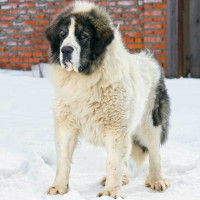 |
Maspyr |
|
He is not recognized by the F.C.I. |
Origin |
Great Britain <> France -> U.S.A. | |
Translation |
Francis Vandersteen |
A brief presentation of the Maspyr |
| The Maspyr is a large, even giant-sized dog that serves as a family protector and companion. It is a specific cross between the pure-bred Mastiff, considered a colossus of a dog, and the pure-bred Pyrenean Mountain Dog, an equally large dog. The Maspyr's size and power are intimidating, and require an owner capable of handling the dog well and promoting healthy socialization. Novice dog owners who are not exposed to owning large dogs are not an ideal partner for the Maspyr. Only two hybrid associations currently recognize the Maspyr: the Designer Breed Registry and the International Designer Canine Registry. |
History of the Maspyr |
| The Maspyr is a specific cross between two large purebred dogs, the Mastiff and the Pyrenean Mountain Dog. The Maspyr is not as popular a hybrid as some others, probably because of its size, and dogs can vary in size, weight and appearance due to the lack of hybrid standards. However, the Maspyr is an excellent family protector, and owners can consult the history of the respective parent breeds for a better understanding of their Maspyr. |
A little of the Mastiff |
||
| The Mastiff is a descendant of Molosser dogs, which were ancient protectors of herds and homes. The Mastiff is a well-documented protector and war dog worldwide. However, the modern Mastiff developed in England in the 15th century as a protector, mainly thanks in part to the Lyme Hall strain of Mastiffs that were bred between the 15th and 20th centuries. The Mastiff thrived in England during this period, however, the breed was threatened with extinction in the early 20th century during the two world wars due to food shortages. Fortunately, breeds imported into the USA and Canada were able to maintain the breed. The American Kennel Club recognized the Mastiff as part of the working group in 1885. | ||
 |
||
| Standard of the Mastiff | ||
A little of the Pyrenean Mountain Dog |
||
| The Pyrenean Mountain Dog originated as a shepherd's dog in the Pyrenees, where the breed has thrived for 5,000 years. The Pyrenean Mountain Dog was once considered a peasant's dog used for herding, but it caught the eye of King Louis XIV in the 17th century and was declared the royal dog of France. As a popular dog among the nobility, the Pyrenean Mountain Dog changed its role to that of estate protector. Pyrenean Mountain Dogs left Europe for Newfoundland, Canada, where the breed enjoyed great popularity. The American Kennel Club first recognized the Pyrenean Mountain Dog in 1933, and the breed enjoys moderate popularity today. | ||
 |
||
| Standard of the Pyrenean Mountain Dog |
Appearance of the Maspyr |
| The Maspyr is a large hybrid, bordering on giant, and makes an excellent house guardian. It most often resembles the Pyrenean Mountain Dog, with its head almost level with the shoulders. The coat is generally abundant and light in hue, although dark markings are also common on the body and face. The Maspyr's frame is robust and powerful, with a large, brushed tail that hangs below body level but curves upwards. The Maspyr's head is large, with a medium-length muzzle and a happy expression of mouth and lips. The Maspyr's eyes are large, round and brown, with a gentle expression as well. |
Temperament of the Maspyr |
| The Maspyr is a gentle giant of a dog that is very protective of its family, especially children. The Maspyr may tend to bark if it resembles the Pyrenean Mountain Dog, but even if it leans towards the silent Mastiff, the Maspyr's sheer size will deter most people. As a great guardian, the Maspyr needs an owner who can help it socialize well. The Maspyr is not generally suited to dogs or other pets, but this too depends on good socialization, and the hybrid can learn to live well with other pets. When it comes to training, the Maspyr tends to be hard-headed and, again, needs a strong, active dog owner to help train it. Maspyr's energy levels are medium to high, and he'll need daily exercise. |
Needs and activities of the Maspyr |
| The Maspyr is an active dog that requires daily exercise of medium to high intensity. Large-breed dogs tend to be much slower, but the active Maspyr is made for high-energy activities and will need to run around. The Maspyr is not well suited to apartment living, as it needs space and a yard to run around. Larger homes with backyards are ideal for these dogs. The Maspyr also prefers colder climates but can tolerate warmer ones. However, be aware of your dog's heat levels and always provide sufficient water and shade outdoors, as this hybrid can easily overheat. |
Maintenance of the Maspyr |
| The Maspyr has a thick, dense coat and is considered a heavy shedder. However, the coat is easy to maintain with a single weekly grooming session. Using a bristle brush, remove dead and loose hairs from the coat to help solve shedding problems. The coat is silky and soft, so dirt won't cling to it and will fall out easily during grooming. Maspyr's size means that weekly grooming can take up to 30 minutes. Bathing the Maspyr is not recommended unless necessary, as the hybrid's skin is very sensitive. While grooming your Maspyr, check its ears for dirt and debris, which can get caught in the densely coated ears that fall off. Regular brushing of teeth and trimming of nails will also keep your Maspyr in top condition. |






 English (United Kingdom)
English (United Kingdom)